
| Top Ten NYC Architecture | top ten New York theaters | |||||||||||||
| For a more complete list, see Theater | ||||||||||||||
| 1 |
Carnegie Hall |
|||||||||||||
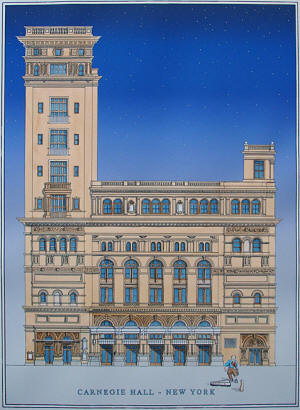 |
Carnegie Hall is a concert hall located in New York City at Seventh Avenue and Fifty Seventh street. Carnegie Hall opened in 1891 and is still used today. Over the last century many world renowned artists have performed there including Peter Tchaikovsky, Igor Stravinsky, and Maurice Ravel and George Gershwin. The Hall is one of the most famous concert halls in the world. The acoustic sounds are impeccable and the architecture is extravagant. |
|||||||||||||
| 2 | Lincoln Center for the Performing Arts | |||||||||||||
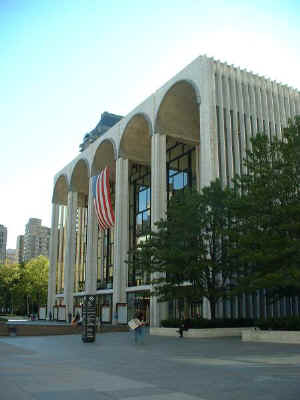 |
Located between west 62nd to west 66th Streets and Columbus and Amsterdam Avenues, the Lincoln Center for the Performing Arts is comprised of a unity of several buildings--all of travertine--devoted to the performance of music, theater, opera, and dance. The overall project was directed by Wallace K. Harrison and completed between 1962 and 1968. The buildings surround an open, user-friendly plaza, even though the buildings are generally conservative in style. The focal point of this complex, the Metropolitan Opera House, is located on the west side of Lincoln Center. It is also the largest of the buildings. The lobby has beautiful paintings by Marc Chagall as well as overwhelming chandeliers of Austrian crystal. |
|||||||||||||
| 3 |
Ed Sullivan Theater |
|||||||||||||
_small.jpg) |
The Ed Sullivan Theater, which is located at 1697-1699 Broadway between West 53rd and West 54th Streets, in Manhattan[1], is a venerable radio and television studio in New York City. The 1200-seat theatre — of which 400 seats are currently used for TV audiences — has been used as a venue for live and taped CBS broadcasts since 1936. It is best known as the longtime home of The Ed Sullivan Show, though since 1993, it has been the home for the Late Show with David Letterman. It is on the list of National Register of Historic Places. |
|||||||||||||
| 4 |
Times Square Theater |
|||||||||||||
|
|
Built by Arch and Edgar Selwyn, was big hit, having big '20s productions such as "Gentlemen Prefer Blondes". Converted to moviehouse in 30s, now waiting to come back to life. |
|||||||||||||
| 5 |
Actor’s Studio |
|||||||||||||
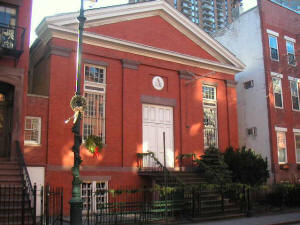 |
|
|||||||||||||
| 6 | The Hippodrome | |||||||||||||
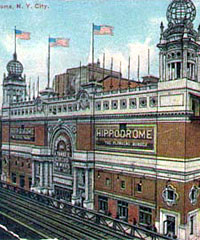 |
The Hippodrome Theatre stood in New York City from 1905 to 1939, on the site of a what is now a large modern office building known as "The Hippodrome Center", at 1120 Avenue of the Americas, in the Theater District of Midtown Manhattan. It was called the world's largest theatre by its builders. The Hippodrome was built by Frederick Thompson and Elmer Dundy, creators of the Luna Park amusement park at Coney Island. The theatre was located on Sixth Avenue, now named Avenue of the Americas, between Forty-third and Forty-fourth streets. Its auditorium seated 5,300 people and it was equipped with what was then the state of the art in theatrical technology. The theatre was acquired by The Shubert Organization in 1909. |
|||||||||||||
| 7 | Radio City Music Hall | |||||||||||||
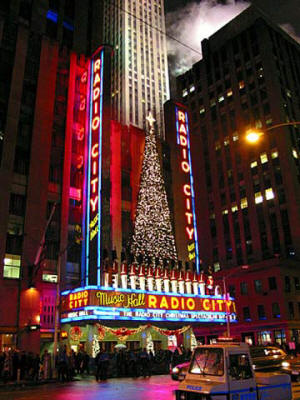 |
The 12 acre (49,000 m²) complex in midtown Manhattan known as Rockefeller Center was developed between 1929 and 1940 by John D. Rockefeller, Jr., on land leased from Columbia University. Rockefeller initially planned a new home for the Metropolitan Opera on the site, but after the Stock Market Crash of 1929, the plans changed and the opera company withdrew from the project. The names "Radio City" and "Radio City Music Hall" derive from one of the complex's first tenants, the Radio Corporation of America. Radio City Music Hall was a project of Rockefeller, Samuel Roxy Rothafel who previously opened the Roxy Theater in 1927, and RCA chairman David Sarnoff. RCA had developed numerous studios for NBC at 30 Rockefeller Plaza, just to the south of the Music Hall, and the radio-TV complex that lent the Music Hall its name is still known as the NBC Radio City Studios. The Music Hall opened to the public on December 27, 1932 with a spectacular stage show, featuring Ray Bolger and Martha Graham. The opening was meant to be a return to high class variety entertainment. Unfortunately, it was not a success and on January 11, 1933, the first film was shown on the giant screen: Frank Capra's The Bitter Tea of General Yen starring Barbara Stanwyck. |
|||||||||||||
| 8 |
Lyceum Theater |
|||||||||||||
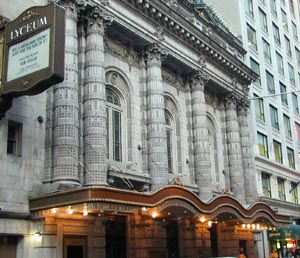 |
The Lyceum Theatre is a legitimate Broadway theatre located at 149 West 45th Street in midtown-Manhattan. It has the distinction of being the oldest surviving Broadway venue (along with the New Amsterdam Theatre), the oldest continuously operating legitimate theatre in New York City, and the first Broadway theatre ever to be granted landmark status (1974). It is one of the few theatres in New York to operate under its original name. Designed by architects Herts & Tallant, the Lyceum was built by impresario Daniel Frohman, whose brother Charles served as manager until his death in 1915. It opened on November 2, 1903 with the play The Proud Prince. |
|||||||||||||
| 9 |
New Amsterdam Theater |
|||||||||||||
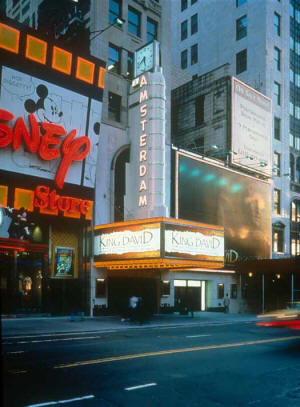 |
Along with the New Victory, Lyceum and Hudson theaters one of the oldest surviving legitimate theaters on Broadway. In 1902 impresarios Marc Klaw and Abraham Erlanger followed Oscar Hammerstein to 42nd Street. But just barely. The theater they commissioned Herts & Tallant to build across from Hammerstein's Republic has a narrow entry on 42nd Street with, the bulk of the house on 41st Street. The 42nd Street Beaux-Arts entrance opens into the finest Art Nouveau theater interiors in NYC. Carved and painted plaster, carved stone, carved wood, murals and tiles—all combine to evoke what it was like going to the theater at the turn of the century. A production of Shakespeare's Midsummer Nights Dream opened the theater on Nov 2, 1903. Florenz Ziegfeld staged his Follies at the New Amsterdam from 1913 through 1927, along with various editions of his other revues, known under various names including The Midnight Frolic and The Nine O'Clock Revue, on the theater's rooftop stage |
|||||||||||||
| 10 |
Madison Square Garden Center |
|||||||||||||
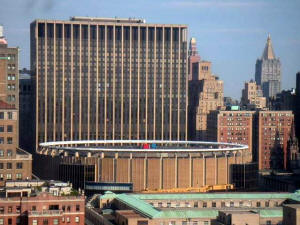 |
Madison Square Garden, often abbreviated as MSG, known colloquially simply as The Garden or The World's Most Famous Arena, has been the name of four arenas in New York City, United States. It is also the name of the entity which owns the arena and several of the professional sports franchises which play there. There have been four incarnations of the arena. The first two were located at the Northeast corner of Madison Square (Madison Ave. & 26th St.) from which the arena derived its name. Subsequently a new 17,000-seat Garden (opened December 15, 1925) was built at 50th Street and 8th Avenue, and the current Garden (opened February 14, 1968) is at 7th Avenue between 31st and 33rd Streets, situated on top of Pennsylvania Station. |
|||||||||||||